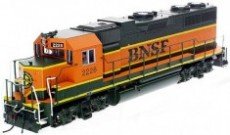Everything on model trains, model railroads, model railways, locomotives, model train layouts, scenery, wiring, DCC and more. Enjoy the world's best hobby... model railroading!
Train Set Power Packs
John sent in this piece of advice to share:
In keeping with Robert Anderson’s Tip about power supplies, it’s time to examine the power that comes with train sets. The power packs that come with most model train sets are not the greatest, and should be considered along with buying locomotives or cars by themselves or in sets. The word “sets” does not include the way some manufacturers include three or more cars with different numbers in a single package, which are usually very good products.
Train sets are relatively inexpensive and are great for putting around a Christmas Tree, or for someone who is just starting out in The World’s Greatest Hobby. For the oval or circle of track that is usually provided, the Power Pack should work accordingly, but expanding the track into a regular railroad may provide difficulties. You get basically what you pay for, and the loco or pack is not up to expectations for making a large layout, but should give you years of good running around a Tree as packaged and put away carefully until next year. A word of caution though – spend a little more and get Nickel Silver track rather than steel track. It works and looks better under “normal” conditions.
As someone who loves running model trains the old way with a Power Pack, I’ve had great results with MRC. Even the less-expensive MRC packs (about $25-$30) work more than adequately for N, but for larger scales it is suggested to go to a more expensive pack with higher readings and more bennies attached to it.
N Gauge Spart Parts
Gil asks for your help:
“I have a Bachmann Plymoth Diesel Shunter and a Lifelike Engine (model unknown) which has trucks at either end with plastic gears inside. Both have worn gears as they are not meshing – where in the world can I buy spare parts or does one just throw them away? If that’s the case no more Bachmann or life like Engines.”
Comment below.
Red Train On Steven’s Layout
Steven sent in this photo of his layout to share. Hopefully he might provide some more details by adding a comment to this posting.
If you would like to have a photo of your layout published or provide a short article about your layout for publication, please use the “Want To Help” link in the right hand column on this blog.
Derailments 18 Inch to 22 Inch Curves
If you are an experienced model railroader you be able to assist Mike with this problem he is having:
“I recently purchased an HO diesel loco with 6 (3 3) trucks. The unit keeps derailing as it goes across turnouts. The problem may relate to my having converted the original layout from 18 inch to 22 inch curves but left the original turnouts in place. If I replace the turnouts with #6’s (22 inch curves) do you think my derailments will be minimized?”
Add your suggestion.
HO Wheels and AMCCW ASSOCIATION OF MANUFACTURERS OF CHILLED CAR WHEELS
Leroy has this question for others in the hobby:
“I have some HO wheel sets that include ‘ASSOCIATION OF MANUFACTURERS OF CHILLED CAR WHEELS A A R 1936’ apparently molded around the axle on the hub. A search shows some data about AMCCW in 1942, but when a model has such detail there must be a link to the real use of this molding in the real world. Can anyone provide information on this (unique?) detail ?”
Comment here.
Digital Layout Points
Ian is asking for advice from readers:
“I have a 00 digital layout and have the digital clips on all points, but still have some problems getting locos to run over them. Any tips to improve the running would be helpful please.”
Add your comment.
Roco Diesel Loco Problem
Mike has a question for readers:
“I have two HO roco diesel locos that do not have tyres 40069. I cannot see how I have to fit these tyres as there are no screws to undo to expose the wheels. On some of the locos there are two tiny screws to undo to get to the wheels. Can someone help me please. ”
Add your suggestion.
Who is your favorite manufacturer of model train locomotives?
Our last poll asked model railroaders – Who is your favorite manufacturer of model train locomotives?
Results were as follows:
Bachmann (25%, 148 Votes)
Other (18%, 108 Votes)
Athearn (17%, 102 Votes)
Kato (14%, 84 Votes)
Atlas (12%, 73 Votes)
Hornby (8%, 49 Votes)
Marklin (4%, 25 Votes)
Life Like (2%, 9 Votes)
Total Voters: 598
Causes of Poor Solder Joints
Jason sent in these thoughts:
Poor solder joints can be a big time waster and cause endless electrical problems on a model railroad layout. Keeping the solder iron tip in first class condition is critical if you want to achieve sound solder joints. Tip problems are easily prevented by always keeping the tip tinned with a thin coating of solder.
Most tips on solder irons are manufactured using a copper core which has been electroplated with iron to prolong the life of the iron. The “non-working” part of the tip is usually plated with nickel to protect against rusting and corrosion. It is then plated with chrome to stop the solder from sticking to it. It is only the very end tip that is un-plated so it will hold the solder.
Recommended model train resources
Looking after a solder iron is important – especially the unplated part of the tip that will quickly oxidize. This is why you need to coat the tip with solder at all times. It will slow down the oxidation process and help keep the tip in good condition. Despite your best intentions, the tip will eventually burn out – they all do. You know this has happened if you struggle to maintain the tip in a clean and shiny condition. If this happens the tip will need to be replaced. Filing or sanding the tip will not solve the problem long term. Tip replacement is best.
To avoid pre-mature burn out of the tip, keep it tinned with a thin coating of solder – not just while you are doing some soldering, but also when your soldering iron is idling. Get into the habit of applying a coat of solder to the tip before you set the iron down.
After you have finished soldering, always clean the tip and then apply a coating of solder prior to switching the iron off.
Whenever you buy and install a new tip, begin by applying a thin coating of solder, because otherwise the tip could burn out within a few minutes.
Types of MOW Equipment
Maintenance of Way (MOW) Equipment is used for laying out the tracks, and for cleaning the area around and under the tracks. There are many categories of railroad equipment including Ballast Cleaning, Rail Grinding and Handling. A few common types are given below.
Ballast Regulator – gives tracks the desired shape.
Clearance Car – ensures that trains do not run into obstacles on the way.
Dynamometer Car – analyzes engine’s performance factors such as speed and power.
Jordan Spreader – removes snow from the railroads, must be operated by the train engine.
Tamper – sets rails along a track, capable of aligning, lifting and tamping rails.
#4 Switches
John would like to hear opinions on Kato #4 Switches:
I don’t know if Kato N-Scale Unitrack is available where you happen to be, but I have found it to be very good, above manufacturers of other roadbed track such as Atlas and Bachmann. However, I have trouble with Kato’s #4 Switches, and I was wondering if others have had trouble with them. #4’s are good to save some space on a small layout or a yard, but the short straight sections that come with the switch to make the track fit bring it out longer, almost to #6 size. The #4 configuration on the back end of the switch can be confusing, and it seems like the modeler has to put power sections all over the place or the engine will stop. #6 switches are power routing but run much better, and can be used on some small layouts.
Add your comment.
Fleischmann v Peco Points
John seeks advice from experienced model railroaders and asks:
“My wife and I are building a 15ft X 9ft HO layout to represent Swiss/Austrian theme. I have used to date some 65 meters of Peco 100 track and 30 points. Problem is that some of my dozen Fleischmann steam locos of various vintage will not run over these points [insulfrog] Is there any way I could ‘doctor’ the reluctant points. Thank you for any advice.”
Add your comment.
DCC Conversion
Rich asks readers:
“I’m fairly new to model railroading. I am confused about something….My layout is Not set up for DCC. Can I run an engine that has DCC on my layout. How hard is it to up grade to DCC if that is the coming thing? Is that something I should do, all my track is in place and a good bit of scenery,will that be a problem. Thanks for any help.”
Comment below.


















